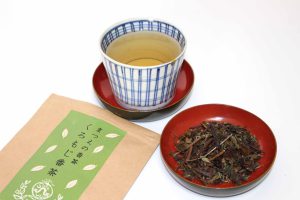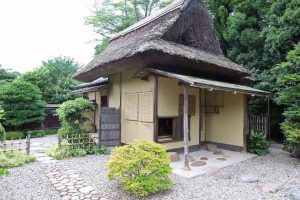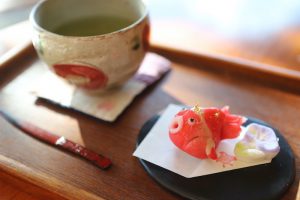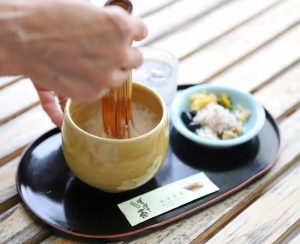MENU
MENU
Tea production area: Matsue City, Izumo City, Unnan City, Sango Town, Yasugi City, Tsuwano Town, Yoshika Town
Brand: Izumo tea, Karakawa tea, Hakuta tea, Botebote tea
Types of tea: Sencha (medium steamed green tea), genmaicha (popped rice green tea), hojicha (roasted green tea), black tea, bancha, flavored tea, etc.
In Shimane Prefecture tea is cultivated with a variety of tea being produced.
Bancha
Bancha is a popular drink in Shimane Prefecture. Bancha has a few meanings and one of them is “local tea”. There are regional brands of bancha, such as Unnan City’s Daido bancha, Yasugi City’s Hakuta bancha, Izumo City’s Karakawa bancha, etc..
Processing these varieties of bancha is simpler than processing sencha. It is done by steaming, drying and roasting tea leaves and not rolling the leaves like with sencha. The finished product of the tea leaf retains its original shape.
Kuromoji bancha is a popular flavored bancha in Shimane Prefecture. The bancha is blended with stems of kuromoji (spicebush) which has a minty flavor. Kuromoji is a deciduous shrub of the Lauraceae family and has a similar minty aroma.

Kuromoji bancha, Yuki Matsue no takarabako 有機まつえ茶の宝箱
MATSUDAIRA Fumai and Matsue’s chanoyu (Japanese tea ceremony) culture
MATSUDAIRA Harusato (1751-1818) was the seventh lord of the Matsue Domain and was called Fumai-kou (Kou is a title of lord). He was also a tea master and established his own tea ceremony school called Fumairyu. Fumai’s style has had influence on tea ceremony utensils and Japanese confectionary for chanoyu (Japanese tea ceremony). The culture of tea and confectionary was developed in Matsue City. Matsue is a famous city for chanoyu and Japanese confectionary as well as Kyoto and Kanazawa are.

Meimeian, a tea house which was built in Fumai’s taste in Matsue City (June 2018)
Matsue tea and beautiful Japanese confectionery can be taken at the café, Kissa Koharu in the Matsue History Museum. The confectionary is made by ITAMI Fumio, Great Craftsman.

Matsue tea and goldfish shaped Japanese confectionary at Kissa Kiharu (August 2018)
There are many shops where you can drink matcha and eat confectionary in Matsue City.
12-300x200.jpg)
A variety of Japanese confectioneries at Seishoan Tachibana in Matsue City (August 2018)
13-300x200.jpg)
Matcha and Japanese confectioneries at Nakamura chaho in Matsue City (August 2018)
Botebote tea
Botebote tea is a traditional food which has been eaten since the Edo Period in the Izumo Region. Botebote tea is a kind of fast food because it can be eaten quickly.
Botebote tea is made by brewing bancha with tea flowers and whisking the tea using a botebote tea’s chasen (bamboo whisk). The tea foams because it is brewed with tea flowers. Then, okowa (steamed glutinous rice), cooked black soybeans, cut pickles, etc. are added to the tea.
Tradition says that the origin of the name of botebote comes from the sound of the whisking of the tea with the chasen.
The chasen used for botebote tea is longer than the one used for matcha and the whisking part is straight, not puffed like the one used for matcha.
There are various theories about the origin of botebote tea with some meaning that it is a meal for Fumai-kou’s falconry, or for fishermen when returning from the sea, or for victims who are suffering because of a natural disaster, or for workers who tread bellows for blowing air in make iron sand, etc. The common point of all of these theories is that it can be eaten quickly.
Now botebote tea can be eaten in tea houses near the Matsue-jo castle.

Botebote tea at Shiomi chaya (August 2018)
Bancha (番茶・晩茶):
Originally bancha means coarse tea in contrast with sencha (medium-steamed green tea). Sencha is produced with new tender tea leaves which plucked in the first tea season in Japan. Bancha is produced with matured hard tea leaves and stems plucked in the late season of the first tea season or in autumn. Shuto bancha means steamed green tea produced with tea leaves plucked in the autumn and early winter.
Additionally, bancha is used for the local special tea, such as Sado bancha of Nigata Prefecture, Mimasaka bancha of Okayama Prefecture, Awa bancha of Tokushima Prefecture, Kyo bancha of Kyoto Prefecture, etc., but each producing method is different.
Tea related facilities:
有機まつえ茶の宝箱 http://www.e-takarabako.com
明々庵 http://www.meimeian.jp/
松江歴史館喫茶きはるhttps://matsu-reki.jp/kiharu/
菓子処 清松庵たちばな http://www.sweet-studio.jp/tachibana/
塩見茶屋 https://www.shiomi-cyaya.com
ちどり茶屋
Ceramic and pottery art: Izumo ware
Reference:
松下智 (平成3年) 日本名茶紀行 (初版) 雄山閣出版
高野實・谷本陽蔵・富田勲・中川致之・岩浅潔・寺本益英・山田新市 (2005) 緑茶の事典 (改訂3版) 柴田書店
大森正司、阿南豊正、伊勢村護、加藤みゆき、滝口明子、中村羊一郎編(2017) 茶の事典 初版第一刷 朝倉書店
社団法人静岡県茶業会議所編(昭和63) 新茶業全書 (8版 全面改定) 社団法人静岡県茶業会議所 三協印刷
世界文化社編(2011) 茶の湯便利手帳3 茶の湯基本用語集初版第一刷 世界文化社
松江歴史館喫茶きはる https://matsu-reki.jp
塩見茶屋 http://www.shiomi-cyaya.com
中村茶舗(松江市) http://www.nippon-tea.co.jp
*When visiting the shops and facilities introduced in this article, please check the business hours on their website, etc. before visiting.
*The information provided on this site may be updated. If you find any information in this article that is incorrect, new, or incomplete, please contact CHAMART.
*The site does not describe all “Teas of Japan” or all “Teas of the World”. Additionally, each article expresses the writer’s personal experience and feelings.
#Botebotecha #botebotetea #shimane #izumotea #matsuetea